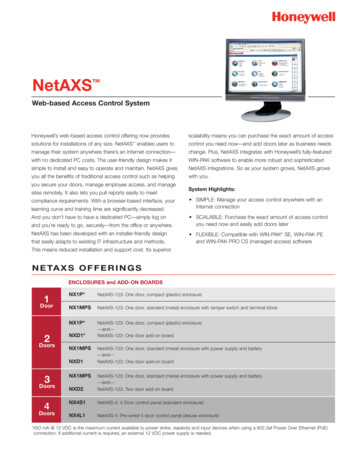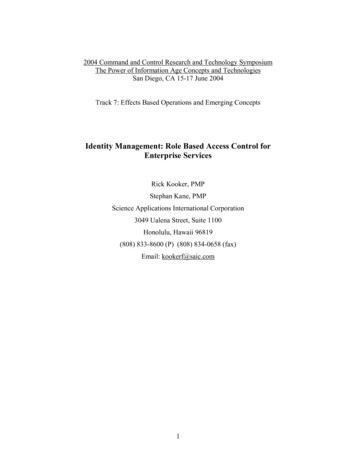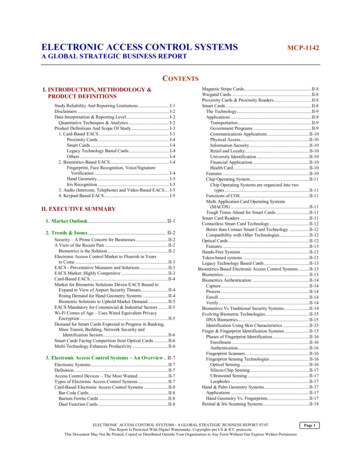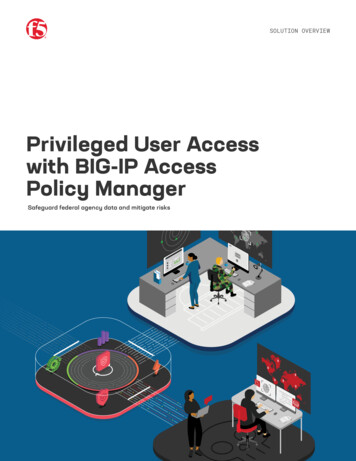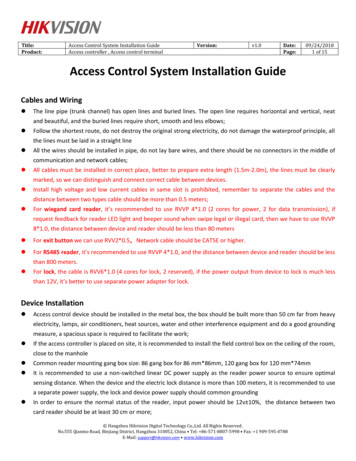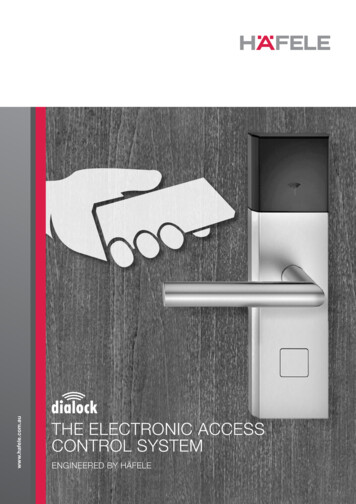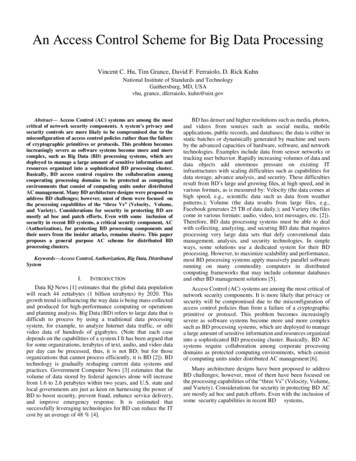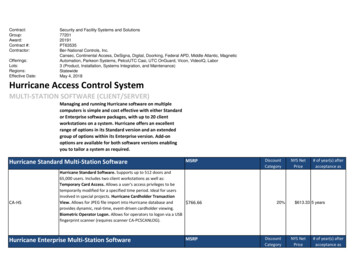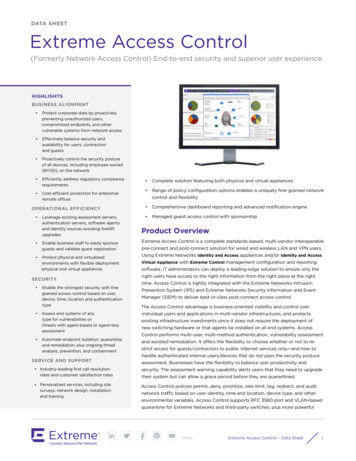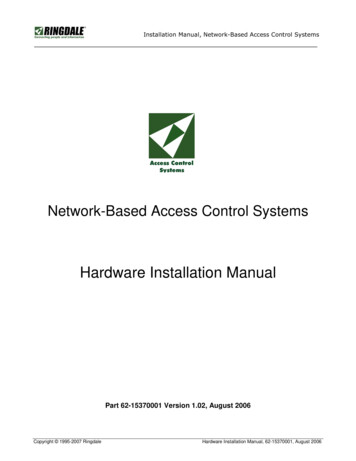
Transcription
Installation Manual, Network-Based Access Control SystemsAccess ControlSystemsNetwork-Based Access Control SystemsHardware Installation ManualPart 62-15370001 Version 1.02, August 2006Copyright 1995-2007 RingdaleHardware Installation Manual, 62-15370001, August 2006
Installation Manual, Network-Based Access Control SystemsTABLE OF CONTENTSNOTE: Please read this manual in its entirety before attempting installationPREAMBLES. 3Copyright. 3Disclaimer . 3Trademarks. 3Technical Prerequisites . 3Technical Support. 3Components Used . 3IMPORTANT INSTALLATION INFORMATION . 4Please read this information before starting the installation process. . 4Recommendation for First Time Installers. 4List of Do’s and Don’ts. 4Wiring Priorities. 5Warning – Safety Isolation. 6Safety Regulations and Fuses. 6Connecting the Power Supply of an Access Controller to the Mains Supply . 6Battery Details . 6INTRODUCTION AND OVERVIEW, ACCESS CONTROL SYSTEMS. 7ACCESS CONTROL SYSTEM HARDWARE CONFIGURATOR. 8UPS POWERSUPPLY 00-16-0444-1100 OVERVIEW . 9DESIGNING A WIRING HARNESS . 10Return Ground Wires. 10 12 Volt Supply Wires . 10Example of Connections Within the Power Supply Box . 10WIRING SCHEMATIC, SINGLE COMBI READER SYSTEM. 11WIRING SCHEMATIC, TWO COMBI READERS SYSTEM . 12Wiring Schematic, Combi Readers, continued . 13WIRING A COMBI READER (KEYPAD OR PROXIMITY VERSION) . 14Connecting a Combi Reader to the Network . 14Connecting a Combi Reader to USB & Ethernet Cables . 15Connecting a Combi Reader to a Relay . 15Connecting a Combi Reader to the Access Controller Power Supply. 16ONE COMBI PROXIMITY & FINGERPRINT ID READER PER ACCESS CONTROLLER . 17CONNECTING A TIME AND ATTENDANCE TERMINAL. 17CONNECTING A DOOR STRIKE LOCK TO THE ACCESS CONTROL SYSTEM . 18CONNECTING A MAGNETIC DOOR LOCK TO THE ACCESS CONTROL SYSTEM . 18CONNECTING A USB RELAY TO THE ACCESS CONTROL SYSTEM. 19USB Relay Wiring Scheme. 19USB Relay Wiring Scheme, Color Coding. 19ACCESS CONTROL SYSTEMS FOR NON-COMBI READERS . 20Wiring Schematic, Single Reader (Non-Combi) Configuration. 20Overview of an Access Control System for Non Combi-Readers . 21Connecting an Access Control System to a Non-Combi Wiring Harness . 21Wiring Scheme Overview for the Access Control System (non-Combi Version) . 22DOOR OVERRIDE BUTTON . 23ENROLLMENT READER OPTION. 24Enrollment Reader Connections. 24Connecting the I.D. Reader to the Controller . 24Non-Optical Fingerprint Beep Codes. 25Optical USB Fingerprint Reader Option . 25CONNECTING THE ACCESS CONTROLLER TO THE MAINS POWER SUPPLY. 25Copyright 1995-2006 RingdaleHardware Installation Manual, 62-15370001, August 2006Page 2 of 26
Installation Manual, Network-Based Access Control SystemsPREAMBLESCopyrightCopyright 2006 Ringdale, Inc. All rights reserved. No part of this publication may bereproduced, transmitted, transcribed, stored in a retrieval system, or translated into any languageor any computer language, in any form or by any third party, without prior permission of RingdaleInc.DisclaimerRingdale Inc. reserves the right to revise this publication and to make changes from time to timeto the contents hereof without obligation to notify any person or organization of such revision orchanges. Ringdale Inc. has endeavored to ensure that the information in this publication iscorrect, but will not accept liability for any error or omission.TrademarksAll trademarks are hereby acknowledged.Technical PrerequisitesThis installation guide for the Ringdale Access Control System assumes that the installer isfamiliar with the basic operation of the following: Microsoft Windows operating systemsMicrosoft Windows ServersEthernet topology, TCP/IP protocolsEthernet routers, switches and hubsBasic principles of wiring and cablingTechnical SupportRingdale Technical Support services help to ensure that Ringdale products and pertinentnetworks operate efficiently and benefit from the most up-to-date system and applicationsoftware. Ringdale offers a flexible suite of support services designed to meet individualbusiness needs and assists in effectively installing and maintaining products and networks tomaintain high-quality network performance.Telephone Technical Support for Ringdale Access Control Systems is available for the Ringdalesubject matter items covered in this installation guide and is provided free-of-charge for theduration of the original warranty period.Technical Support from Ringdale is also available for all of the above listed prerequisites. Thecurrent terms, conditions and rates for Technical Support are available on request, minimum twohours.Components UsedThe information in this document was created from the devices in a specific lab environment. Allof the devices used in this document started with a cleared (default) configuration.Copyright 1995-2006 RingdaleHardware Installation Manual, 62-15370001, August 2006Page 3 of 26
Installation Manual, Network-Based Access Control SystemsIMPORTANT INSTALLATION INFORMATIONPlease read this information before starting the installation process.Recommendation for First Time InstallersIf you are installing a Ringdale Access Control system for the very first time and prior to startingthe installation process, we strongly recommend that you implement an installation “dry run” toacquaint yourself with each of the components and the overall operation of the system. Using asuitable table as a test-bed, simply wire each item of the proposed system together as per theappropriate schematic described in the next few pages of this document. From this test-bed youwill then get a better understanding of how and where each item is connected / wired together tomake a complete system and you will be able to verify that the power supply is working and thateach ID Reader, Relay and Door Lock is functioning correctly. Once you have verified thesystem in this manner, it is then just a matter of extending the cable lengths to meet the actualinstallation criteria. And if for whatever reason you are experiencing problems with the system onthe test-bed, it makes problem determination and resolution via the Ringdale Technical Supportgroup so much easier at this stage than if the system has been fully installed.List of Do’s and Don’ts1. To prevent damage to components and circuitry, it is imperative that the power connectionsfrom the battery and power supply be attached to the user-installed wiring harness AFTERall other connections are made. Put another way; complete the wiring connection to all of thevarious components (ID Readers, Keypads, Locks, Relays, etc.) BEFORE connecting thebattery and power supply into the circuit.2. Do not connect an ID Reader and a Relay in series. Each ID Reader, Keypad, Relay andLock must have its own dedicated 12 Volt cabling run from the Battery/Power Supply. Dueto the current spike that occurs when a relay and door strike are activated, serious systemerrors will occur if this instruction is not heeded.3. When planning the cabling schematic for an installation, use the appropriate gauge wire forsupplying power to the various door locks available from different vendors. For example,please note the following:Lock ManufacturerHessRCIRequiredVoltage12 Volts DC12 Volts DCCurrent Draw(Milliamps)Comments400225Various models, varying current drawVarious models, varying current drawIf the total power consumption of the door locks for any one Access Control system exceeds500 mA, then one power supply must be used for the ID Readers and Access Controller,while a separate power supply must be used to power the Relays and Locks.4. The green earth connection from the mains power supply MUST NOT be removed from theterminal on the side of the Access Control box, it must remain connected at all times.Copyright 1995-2006 RingdaleHardware Installation Manual, 62-15370001, August 2006Page 4 of 26
Installation Manual, Network-Based Access Control SystemsIMPORTANT INSTALLATION INFORMATION, continued5. The Power Supply for the Access Control system should only be powered-on with a batteryin the circuit. If for any reason there is a need to test or use the Power Supply without abattery fitted, please ensure that the connectors at the end of the battery leads are insulatedand cannot cause a short.6. If it becomes necessary to upgrade the firmware on the Access Control system, or reset thecontroller to its factory default settings, please contact Ringdale technical support to beguided through the procedure (contact details at the back of this manual).7. When installing the Access Control system, please take into account the length of cablerequired to connect the controller to the various ID devices, card readers, network and mainspower supply.The maximum wire length ( 12 Volt and Return Ground wires) between the Battery/PowerSupply and any device should be 300 feet maximum. This is due to the electricalcharacteristics and current drop associated with carrying 12 Volt DC over 20 SWG wire.8. For security and safety considerations, all wiring connections to the Power Supply should behoused inside the UPS box. In all possible hardware configurations, an appropriate sizedwire nut should be used to connect all of the 12 Volt wires together. In all possiblehardware configurations, an appropriate sized wire nut should be used to connect all of theReturn Ground wires together. These wire connections must be housed inside the powersupply box.9. All wiring must follow local wiring codes. Failure to follow local wiring codes may result inserious damage to components or become a fire hazard. Ringdale Inc. cannot be heldresponsible for any damage caused by faulty or sub-standard wiring practices performedduring the installation process.10. In any of the Access Controller configurations (one or two ID Reader configurations, etc), allReturn Ground wires will need to be gathered together within the Power Supply box and tiedtogether via a wiring nut. Similarly, all 12 Volt wires will need to be gathered together withinthe Power Supply box and tied together via a wiring nut.Wiring Priorities1)For ease of installation and integrity of connections, it is recommended that strandedcopper wire be used for all wiring runs from the Power Supply to the various ancillaries.2)Build the 12-volt and Return Ground wiring harness and connect all the systemcomponents (ID Readers, Relays, Door Strikes, etc) to it, but do not connect the batteryor power supply to the wiring harness.3)After stage (2) above is completed, connect the 12-volt wiring harness to the powersupply PCBA.4)After stages (2) and (3) above are completed, connect the battery to the power supply.5)When all other wiring stages and connections are completed, then is the time to plug the110-volt power cable into the receptacle at the top left-hand side of the power supply.Copyright 1995-2006 RingdaleHardware Installation Manual, 62-15370001, August 2006Page 5 of 26
Installation Manual, Network-Based Access Control SystemsIMPORTANT INSTALLATION INFORMATION, continuedWarning – Safety IsolationWhen connecting the Power Supply of an Access Control system to the mains electricity supply,first ensure that the Power Supply is safely isolated.Safety Regulations and FusesDepending on the local safety regulations, it is recommended that the Access Control powersupply be connected to a switchable and/or fused distribution point with a higher rating than theinternal mains fuse. Fuse rating for fuse F1 (Mains Fuse) is T1.0 A/250V SloBlo Fuse rating for fuse F2 (Battery Fuse) is T3.15 A/125VAlways replace a fuse with one of the same rating.For safety reasons the mains electricity transformers are in the protective casing at the top of theAccess Control Box.Connecting the Power Supply of an Access Controller to the Mains SupplyDo not connect the power supply of an Access Controller to the 110 Volt mains supply until afterthe 12 Volt and Return Ground wiring harness has been completed and all other components ofthe system (ID Readers, Keypads, Relays, Locks, etc) have been connected to the PowerSupply. Failure to do so may cause damage to components and circuitry and void the factorywarranty.When all of the aforementioned wiring has been completed, use the supplied power cable toconnect the system to a standard 110 Volt wall outlet. The mains connector is located on the topleft-hand side of the box.Battery DetailsRingdale can supply a suitable 18 Ah battery for the Access Control system. If the customerwants to supply the battery separately, then any sealed lead-acid type rechargeable battery of12V DC with 1.2Ah up to 18Ah should be suitable, up to a maximum physical size of:Width: 180 mmDepth: 75 mmHeight: 167 mmThe storage capacity of the battery to be used will depend on your particular requirements. Anexample of a suitable 1.2 Ah battery is the YUASA NP1 2-12. An example of a suitable 18 Ahbattery is the Universal Battery UB12180.The (positive) and - (negative) battery leads fit to the respective connectors on the battery(Note: two sets of leads with different connectors are supplied with all Access Control Systems,use the type that is suitable for the battery that you are fitting).Copyright 1995-2006 RingdaleHardware Installation Manual, 62-15370001, August 2006Page 6 of 26
Installation Manual, Network-Based Access Control SystemsINTRODUCTION AND OVERVIEW, ACCESS CONTROL SYSTEMSThis guide is designed to provide hardware installation instructions for the Ringdale NetworkBased Access Control Systems.The Ringdale Access Control System is a modular design that allows the end-user or installer toconfigure a complete Access Control system by selecting the required security devices from acatalogue of supplementary items. A typical configuration would consist of the Access Controller(UPS Power Supply complete with battery), one or two ID readers or keypads and up to tworelay-activated Door Strikes or Magnetic Locks. In normal operation the battery is trickle chargedvia a mains transformer and during a power failure the battery continues supplying power (UPS)to the system.Each Network-Based Access Control system is connected to the Sentinel centralizedmanagement and configuration software from Ringdale via any Ethernet network, providingcomprehensive management and monitoring capabilities. The Sentinel management softwaredelivers superior functionality and a high standard of supervision (see the separate “SentinelSoftware Installation and Configuration Guide” that accompanies the product).When designing an Access Control system, the starting point is to select the Identification (ID)Readers and Door Locks that best suit the needs of the end-user and their building. Ringdaleprovides a wide selection of Readers for just about every need, including Fingerprint, ProximityCard, Magnetic Swipe, Keypads, Combination Readers (Combis) and Time and Attendanceterminals. When you have selected the applicable reader(s), you will then need to select theappropriate Ringdale UPS Power Supply / Access Controller, of which at present there are three
The Power Supply for the Access Control system should only be powered-on with a battery in the circuit. If for any reason there is a need to test or use the Power Supply without a battery fitted, please ensure that the
